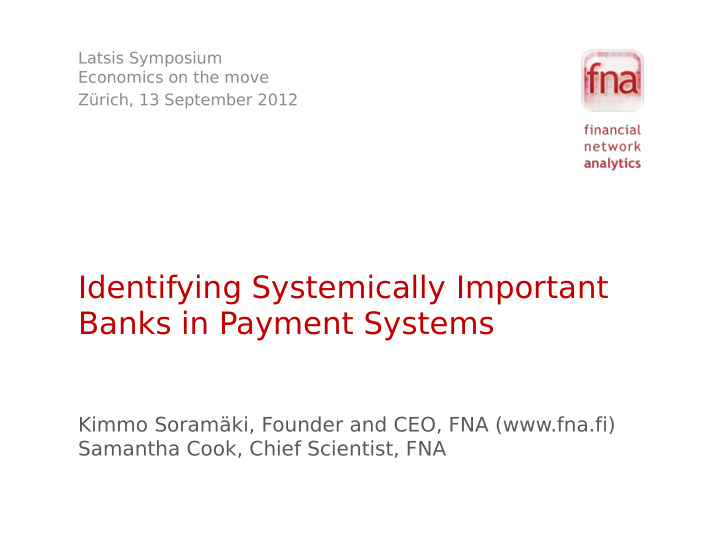



Latsis Symposium Economics on the move Zürich, 13 September 2012 Identifying Systemically Important Banks in Payment Systems Kimmo Soramäki, Founder and CEO, FNA (www.fna.fi) Samantha Cook, Chief Scientist, FNA
Interbank Payment Systems • Provide the backbone of all economic transactions • Banks settle claims arising from customers transfers, own securities/FX trades and liquidity management • T arget 2 settled 839 trillion in 2010
Systemic Risk in Payment Systems • Credit risk has been virtually eliminated by system design (real-time gross settlement) • Liquidity risk remains – “Congestion” – “Liquidity Dislocation” • Trigger may be – Operational/IT event – Liquidity event – Solvency event Time scale is intraday, spillovers possible •
Agenda • Centrality in Networks • SinkRank • Experiment and Results • Implementation
Centrality in Networks
Common centrality metrics Centrality metrics aim to summarize some notion of importance Degree: number of links Closeness: distance from/to other nodes via shortest paths Betweenness: number of shortest paths going through the node Eigenvector: nodes that are linked by other important nodes are more central, probability of a random process
Eigenvector Centrality • Problem: EVC can be (meaningfully) calculated only for “Giant Strongly Connected Component” (GSCC) • Solution: PageRank
PageRank • Solves the problem with a “Damping factor” α which is used to modify the adjacency matrix (S) – Gi,j= α Si,j + (1−α)/Ν • Effectively allowing the random process out of dead-ends (dangling nodes), but at the cost of introducing error Effect of α • – α=0 −> Centrality of each node is 1/N – α=1 −> Eigenvector Centrality – Commonly α=0.85 is used α=0.85 α=1 (0.375, 0.375, 0.25)
Which Measure for Payment Systems?
Centrality depends on process • • Trajectory T ransmission – Parallel duplication – Geodecis paths (shortest paths) – Serial duplication – Any path (visit no node twice) – Transfer – Trails (visit no link twice) – Walks (free movement) Source: Borgatti (2004)
Distance to Sink • Markov chains are well-suited to model transfers along walks • Absorbing Markov Chains give distances: From B 1 T o A 2 From C From A (66.6 (100% T o B %) ) From C 1 (33.3 %) From A T o C From B (100% )
SinkRank SinkRanks on unweighed • SinkRank is the average distance networks to a node via (weighted) walks from other nodes • We need an assumption on the distribution of liquidity in the network at time of failure – Asssume uniform -> unweighted average – Estimate distribution -> PageRank -weighted average – Use real distribution -> Real distribution are used as weights
SinkRank – effect of weights “Real” Uniform PageRank (A: 5% B: 90% (A,B,C: (A: 37.5% B: 37.5% C:5%) 33.3% ) C:25%) Note: Node sizes scale with 1/SinkRank
How good is it?
Experiments • Design issues – Real vs artificial networks? – Real vs simulated failures? – How to measure disruption? • Approach taken 1. Create artificial data with close resemblance to the US Fedwire system (BA-type, Soramäki et al 2007) 2. Simulate failure of a bank: the bank can only receive but not send any payments for the whole day 3. Measure “Liquidity Dislocation” and “Congestion” by non-failing banks 4. Correlate 3. (the “Disruption”) with SinkRank of the failing bank
Data generation process Based on extending Barabasi–Albert model of growth and preferential attachment
Distance from Sink vs Disruption Relationship between Failure Distance and Disruption when the most central bank fails Highest disruption to banks whose liquidity is absorbed first (low Distance to Sink) Distance to Sink
SinkRank vs Disruption Relationship between SinkRank and Disruption Highest disruption by banks who absorb liquidity quickly from the system (low SinkRank)
Implementing SinkRank
Implementation example available at www.fna.fi
More information at www.fna.fi www.fna.fi/blog Kimmo Soramäki, D.Sc. kimmo@soramaki.net T witter: soramaki Discussion Paper, No. 2012-43 | September 3, 2012 | http://www.economics-ejournal.org/economics/discussionpapers/2012-43
Recommend
More recommend